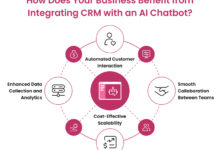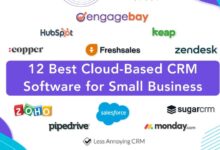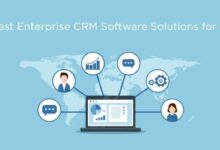CRM for Sales and Marketing Automation
CRM for Sales and Marketing Automation represents a powerful synergy, streamlining processes and boosting efficiency. This integration allows businesses to leverage a unified platform for managing customer relationships, nurturing leads, and automating marketing campaigns, ultimately driving revenue growth and improving customer satisfaction. By connecting sales and marketing data, companies gain valuable insights into customer behavior, enabling data-driven decision-making and more effective resource allocation.
This exploration delves into the core functionalities of such systems, highlighting the key distinctions between sales-centric and fully integrated solutions. We’ll examine the substantial benefits of this unified approach, including enhanced data visibility, improved ROI, and streamlined workflows. The discussion will cover essential features, implementation strategies, performance measurement, and future trends shaping this dynamic field.
Defining CRM for Sales and Marketing Automation
A Customer Relationship Management (CRM) system, when enhanced with marketing automation capabilities, becomes a powerful tool for businesses to manage interactions with current and potential customers. It integrates sales and marketing efforts, providing a unified view of the customer journey and facilitating more efficient and effective processes. This integrated approach allows for better lead nurturing, improved sales conversion rates, and ultimately, increased revenue.
A CRM system designed for sales and marketing automation offers a comprehensive suite of functionalities. Core features typically include contact management, lead management, sales pipeline tracking, marketing campaign management, and reporting and analytics. Contact management provides a centralized database to store and manage all customer information. Lead management helps identify and qualify potential customers, while sales pipeline tracking monitors the progress of sales opportunities. Marketing campaign management enables the creation and execution of automated marketing campaigns, and reporting and analytics provide insights into campaign performance and customer behavior. These functionalities work in concert to create a seamless flow of information and activity throughout the customer lifecycle.
Core Functionalities of a Sales and Marketing Automation CRM
The core functionalities of a sales and marketing automation CRM are designed to break down silos between sales and marketing, creating a more cohesive and efficient approach to customer engagement. Contact management provides a single source of truth for all customer interactions, regardless of the department involved. Lead scoring and qualification automate the process of identifying high-potential leads, ensuring that sales teams focus their efforts on the most promising opportunities. Marketing automation tools allow for personalized communication at scale, nurturing leads through automated email sequences and targeted advertising. Sales pipeline management provides real-time visibility into the sales process, allowing for proactive intervention and improved forecasting. Finally, robust reporting and analytics capabilities provide data-driven insights into campaign performance, sales effectiveness, and customer behavior, informing future strategies.
Sales-Focused CRM vs. Integrated Sales and Marketing Automation CRM
The key difference lies in the scope of functionality. A sales-focused CRM primarily concentrates on managing sales activities, such as tracking leads, managing opportunities, and forecasting sales. While it may include some basic marketing features, it lacks the advanced automation capabilities of a fully integrated system. In contrast, a CRM with integrated marketing automation offers a wider range of functionalities, including automated email marketing, lead nurturing, campaign management, and social media integration. This allows for a more holistic approach to customer engagement, aligning sales and marketing efforts to achieve shared goals. For example, a sales-focused CRM might simply track email communications, whereas a fully integrated system could automate email sequences based on lead behavior and scoring, significantly increasing engagement and conversion rates.
Streamlining Sales and Marketing Processes with CRM
CRM systems streamline sales and marketing processes in several ways. For sales, a CRM system can automate repetitive tasks like data entry, lead assignment, and follow-up communications, freeing up sales representatives to focus on building relationships and closing deals. For marketing, a CRM system enables the creation and execution of targeted marketing campaigns, personalized messaging, and automated lead nurturing, improving lead generation and conversion rates. For example, a marketing campaign might trigger an automated email sequence when a prospect downloads a white paper, leading them through the sales funnel with increasingly targeted messages. The integrated nature of a sales and marketing automation CRM ensures that both teams have access to the same customer data, eliminating information silos and improving communication and collaboration. This results in a more efficient and effective overall approach to customer acquisition and retention.
Benefits of Integrated Sales and Marketing Automation
Integrating sales and marketing automation within a unified CRM system offers significant advantages over maintaining separate systems. This streamlined approach fosters better collaboration, improved data visibility, and ultimately, increased efficiency and revenue generation. By breaking down data silos and fostering a holistic view of the customer journey, businesses can optimize their strategies and achieve a higher return on investment.
Improved Data Visibility Enhances Sales and Marketing Performance
A unified CRM provides a 360-degree view of each customer, encompassing all interactions across sales and marketing channels. This holistic view eliminates data inconsistencies and allows for more accurate segmentation, targeted campaigns, and personalized customer experiences. Sales teams gain access to real-time marketing campaign performance data, enabling them to adjust their outreach strategies and prioritize high-potential leads. Marketing teams benefit from sales insights, such as lead conversion rates and customer feedback, allowing for continuous campaign optimization and improved lead nurturing strategies. The result is a more efficient and effective sales and marketing engine, leading to higher conversion rates and increased revenue.
Real-World Examples of Successful Integrated CRM Systems
Many businesses have successfully leveraged integrated CRM systems to achieve remarkable results. For instance, Salesforce, a leading CRM provider, often cites case studies of companies that have significantly improved their sales and marketing performance through the use of their platform. These case studies frequently demonstrate improved lead conversion rates, increased sales revenue, and enhanced customer satisfaction. While specific numbers vary based on the company and its implementation, the consistent theme is a substantial improvement in overall business performance resulting from better data visibility and streamlined workflows. Another example could be a mid-sized e-commerce company using HubSpot, where the integration of sales and marketing functionalities allowed for automated email sequences triggered by customer behavior, leading to a demonstrable increase in sales conversions.
Return on Investment (ROI) Comparison: Separate vs. Integrated Systems
| Metric | Separate Sales & Marketing Systems | Integrated CRM System | Difference |
|---|---|---|---|
| Lead Conversion Rate | 10-15% (estimated) | 20-30% (estimated) | +10-20% |
| Marketing Campaign ROI | 15-25% (estimated) | 30-40% (estimated) | +15-20% |
| Sales Cycle Length | 6-8 weeks (estimated) | 4-6 weeks (estimated) | -2 to -4 weeks |
| Customer Acquisition Cost (CAC) | High (due to inefficiencies) | Lower (due to efficiency gains) | Significant Reduction |
Note: These figures are estimates and will vary based on factors such as industry, company size, and the specific CRM system implemented. The aim is to illustrate the potential for increased ROI with an integrated system. Real-world ROI can be significantly higher or lower depending on various factors.
Key Features of a Robust CRM System
A robust CRM system designed for sales and marketing automation goes beyond simple contact management. It integrates various tools and functionalities to streamline processes, improve efficiency, and ultimately drive revenue growth. A well-implemented CRM acts as the central hub for all customer interactions, providing a unified view of each customer’s journey.
A truly effective CRM system offers a comprehensive suite of features that work together seamlessly. These features fall broadly into categories focused on managing leads, contacts, sales processes, and marketing efforts. The integration of these components is crucial for maximizing the system’s impact.
Lead Management
Effective lead management is fundamental to sales success. The CRM should provide tools to capture, qualify, nurture, and convert leads into paying customers. This includes features such as lead scoring (automatically assigning points based on predefined criteria, such as website activity or engagement with marketing emails), lead routing (automatically assigning leads to the appropriate sales representative based on territory or expertise), and lead nurturing workflows (automated email sequences designed to engage and educate prospects). For example, a lead scoring system might assign higher points to leads who download a whitepaper or attend a webinar, indicating a higher level of interest and engagement. The CRM then uses this score to prioritize leads and ensure that high-potential prospects receive prompt attention.
Contact Management
A CRM’s contact management capabilities are essential for maintaining accurate and up-to-date information about customers and prospects. This includes features for storing detailed contact information (name, email address, phone number, company, etc.), tracking interactions (email exchanges, phone calls, meetings), and segmenting contacts (grouping contacts based on shared characteristics, such as industry or purchase history). Effective contact management enables personalized communication and targeted marketing campaigns. Imagine a scenario where a sales representative can quickly access a complete history of interactions with a client, including past purchases and any outstanding issues. This allows for more informed and effective communication, strengthening customer relationships.
Sales Pipeline Management
Visualizing and managing the sales pipeline is crucial for tracking progress and identifying bottlenecks. A CRM should offer tools to create and customize sales pipelines, track deals at each stage of the process, and forecast revenue. Features such as customizable stages, progress tracking, and reporting capabilities provide valuable insights into sales performance. For instance, a sales manager can use the CRM to identify deals that are stalled in a particular stage, allowing them to intervene and provide support to the sales team. This real-time visibility improves sales forecasting accuracy and facilitates proactive intervention to address potential issues.
Marketing Automation Tools
Integration of marketing automation tools within the CRM streamlines marketing efforts and enhances efficiency. Email marketing capabilities allow for creating and sending targeted email campaigns, automating follow-up sequences, and tracking campaign performance. Social media integration enables monitoring social media mentions, engaging with prospects on social platforms, and running social media advertising campaigns directly from the CRM. For example, a company could use the CRM to segment its customer base into different groups based on their purchase history and send targeted email promotions. This allows for more effective marketing, increasing conversion rates and improving customer engagement.
- Lead Management: Automating lead capture, scoring, routing, and nurturing for improved sales efficiency.
- Contact Management: Centralized storage and management of customer data for personalized interactions.
- Sales Pipeline Management: Visualizing and tracking sales progress, identifying bottlenecks, and forecasting revenue.
- Marketing Automation: Integrating email marketing, social media management, and other tools for streamlined marketing efforts.
Implementing and Managing a CRM System
Successfully implementing a CRM system requires a strategic approach that considers various factors, from initial planning to ongoing maintenance. A well-executed implementation plan ensures the system aligns with business goals and delivers a strong return on investment. Failure to adequately plan can lead to underutilization, data inconsistencies, and ultimately, a failed CRM project.
Step-by-Step CRM Implementation Plan
A phased approach to implementation minimizes disruption and allows for iterative improvements. Each phase builds upon the previous one, ensuring a smooth transition and maximizing user adoption.
- Needs Assessment and Planning: Define specific business objectives, identify key performance indicators (KPIs), and choose the right CRM system based on these needs and budget. This involves detailed analysis of current processes, user roles, and data requirements.
- System Selection and Customization: Select a CRM system that aligns with the business needs identified in the previous phase. This may involve customizing the system to fit specific workflows and integrating it with existing systems. Consider cloud-based vs. on-premise options and the associated costs and benefits.
- Data Migration and Cleansing: Clean and migrate existing data from legacy systems into the new CRM. This process requires careful planning and execution to ensure data accuracy and consistency. Data mapping and validation are crucial steps in this phase. Inconsistencies should be addressed before migration.
- User Training and Adoption: Provide comprehensive training to all users on how to effectively utilize the CRM system. This training should be tailored to different user roles and responsibilities. Ongoing support and resources should be made available.
- Testing and Deployment: Thoroughly test the system to identify and resolve any issues before full deployment. A phased rollout to different departments or user groups can help manage risk and identify potential problems early on.
- Ongoing Maintenance and Optimization: Regularly monitor system performance, update software, and make necessary adjustments to ensure the CRM continues to meet evolving business needs. This includes data backups, security updates, and performance tuning.
Data Migration and Integration Best Practices
Successful data migration is paramount for a functional CRM. Poorly executed migration can lead to inaccurate data, hindering the system’s effectiveness.
Best practices include:
- Data Cleansing: Identify and correct inconsistencies, duplicates, and outdated information before migration. This ensures data quality and accuracy in the new system.
- Data Mapping: Carefully map fields and data structures from the old system to the new CRM to ensure seamless data transfer.
- Phased Migration: Migrate data in stages to minimize disruption and allow for testing and correction of any errors.
- Data Validation: Validate the migrated data to ensure accuracy and completeness after the migration process is complete. Regular checks for data integrity should be implemented.
- API Integration: Utilize application programming interfaces (APIs) to seamlessly integrate the CRM with other business systems, such as marketing automation platforms and ERP systems. This eliminates manual data entry and ensures data consistency across platforms.
User Training and System Maintenance Strategies
Effective user training and ongoing maintenance are vital for maximizing CRM adoption and return on investment.
Strategies for user training include:
- Role-Based Training: Tailor training to the specific needs and responsibilities of different user groups.
- Hands-on Training: Provide practical, hands-on training sessions that allow users to practice using the system.
- Ongoing Support: Offer ongoing support and resources, such as FAQs, tutorials, and help desk support.
- Gamification: Incentivize user adoption through gamification techniques, such as leaderboards and rewards.
Strategies for system maintenance include:
- Regular Backups: Regularly back up CRM data to protect against data loss.
- Software Updates: Apply software updates and patches promptly to ensure system security and performance.
- Performance Monitoring: Monitor system performance regularly to identify and address any issues.
- Security Audits: Conduct regular security audits to identify and mitigate potential security risks.
Common CRM Implementation Challenges and Solutions
Several challenges can arise during CRM implementation. Proactive planning and mitigation strategies are crucial for successful outcomes.
| Challenge | Solution |
|---|---|
| Lack of User Adoption | Comprehensive training, gamification, and ongoing support. |
| Data Migration Issues | Thorough data cleansing, mapping, and validation before migration. Phased approach. |
| Integration Problems | Utilize APIs for seamless integration with other systems. |
| Inadequate Training | Provide role-based, hands-on training with ongoing support. |
| Insufficient System Customization | Customize the system to fit specific business needs and workflows. |
Measuring the Effectiveness of CRM
Implementing a CRM system is only half the battle; understanding its impact on your business is crucial. Measuring the effectiveness of your CRM involves establishing clear Key Performance Indicators (KPIs), analyzing the data generated, and using those insights to refine your sales and marketing strategies. This ensures your investment pays off and drives tangible results.
Establishing Key Performance Indicators (KPIs)
Effective KPI selection is paramount for accurate CRM performance assessment. These metrics should directly reflect your business objectives and provide actionable insights. Choosing the wrong KPIs can lead to misinterpretations and ineffective strategy adjustments. For example, focusing solely on lead generation without considering conversion rates can paint a misleading picture of success. Instead, a balanced scorecard approach is recommended, encompassing various aspects of the sales and marketing funnel.
Analyzing Sales and Marketing Data Generated by the CRM
Your CRM system is a goldmine of data. Analyzing this data allows you to identify trends, pinpoint bottlenecks, and understand customer behavior. This analysis can involve various techniques, including:
- Sales pipeline analysis: Tracking the movement of leads through different stages of the sales process helps identify areas where deals are getting stuck or lost.
- Marketing campaign performance: Measuring the effectiveness of different marketing campaigns (email, social media, etc.) by tracking metrics like open rates, click-through rates, and conversion rates.
- Customer segmentation analysis: Grouping customers based on shared characteristics (demographics, purchasing behavior, etc.) to tailor marketing efforts and improve targeting.
- Sales representative performance: Evaluating individual sales representative performance based on metrics like deal closure rate, average deal size, and number of qualified leads generated.
These analyses should be conducted regularly, allowing for timely identification and resolution of potential issues.
Using Data to Improve Sales and Marketing Strategies
Data analysis isn’t just about understanding the past; it’s about shaping the future. The insights gained from CRM data analysis can be used to refine various aspects of your sales and marketing strategies. For example, if your analysis reveals a low conversion rate at a specific stage of the sales pipeline, you can adjust your sales process or training programs to address the bottleneck. Similarly, if a particular marketing campaign underperforms, you can revise your messaging, targeting, or channel selection. This iterative process of data analysis and strategy refinement is essential for maximizing the ROI of your CRM system.
Visual Representation of CRM Usage and Business Metrics
Imagine a graph with two lines. The X-axis represents time (e.g., months). The Y-axis represents a key business metric, such as revenue. One line shows the revenue trend before CRM implementation, perhaps showing a relatively flat or slowly increasing trajectory. The second line depicts revenue after CRM implementation. This line should ideally show a steeper, more significant upward trend, reflecting improved sales efficiency and effectiveness. The difference between the two lines visually represents the positive impact of the CRM system on revenue generation. A similar graph could be created for other key metrics like customer acquisition cost (CAC) or customer lifetime value (CLTV), demonstrating how CRM usage affects these crucial business indicators. The visual clearly demonstrates the correlation between improved CRM usage (leading to better sales and marketing efficiency) and improved key business metrics (like revenue growth or reduced CAC).
Future Trends in CRM for Sales and Marketing Automation
The landscape of Customer Relationship Management (CRM) is constantly evolving, driven by technological advancements and changing customer expectations. The integration of artificial intelligence (AI) and machine learning (ML) is reshaping how businesses interact with their customers, automating processes, and driving significant improvements in sales and marketing effectiveness. This section will explore some of the key emerging trends and their impact on the future of CRM.
AI and Machine Learning Integration in CRM
The integration of AI and ML is revolutionizing CRM systems. AI-powered features are enhancing various aspects of sales and marketing automation, from lead scoring and segmentation to personalized communication and predictive analytics. These technologies enable CRM systems to analyze vast amounts of data, identify patterns, and make predictions about customer behavior, leading to more targeted and effective marketing campaigns and improved sales conversion rates. For example, AI-powered chatbots are increasingly used to provide instant customer support, freeing up human agents to focus on more complex issues. Predictive lead scoring algorithms prioritize leads with a higher probability of conversion, enabling sales teams to focus their efforts more efficiently.
Predictive Analytics and Customer Segmentation
Predictive analytics, powered by machine learning algorithms, allows businesses to anticipate customer behavior and personalize interactions. By analyzing historical data and identifying patterns, CRM systems can predict customer churn, identify potential upselling opportunities, and segment customers into more granular groups based on their needs and preferences. This leads to more effective marketing campaigns, improved customer retention, and increased revenue. For instance, a retail company might use predictive analytics to identify customers at risk of churning and proactively offer them discounts or loyalty programs to retain them. Similarly, a SaaS company might use predictive analytics to identify which customers are most likely to upgrade to a premium plan, allowing them to target them with specific marketing messages.
Hyper-Personalization and Enhanced Customer Experience
AI-powered CRM systems enable hyper-personalization, allowing businesses to tailor their interactions with each customer based on their individual preferences and behavior. This goes beyond basic segmentation and involves delivering personalized content, offers, and support at every touchpoint. For example, an e-commerce website might use AI to recommend products based on a customer’s browsing history and past purchases, creating a more engaging and personalized shopping experience. This level of personalization leads to increased customer satisfaction, loyalty, and ultimately, higher sales conversion rates. Real-world examples include Netflix’s recommendation engine and Amazon’s personalized product suggestions.
Automation and Increased Efficiency
AI and ML are automating many time-consuming tasks within CRM systems, freeing up sales and marketing teams to focus on more strategic initiatives. Tasks such as lead qualification, appointment scheduling, and follow-up emails can be automated, improving efficiency and reducing manual workload. This increased efficiency leads to higher productivity, faster sales cycles, and a better overall return on investment (ROI) for CRM systems. For instance, a real estate agency could automate lead follow-up with personalized emails triggered by specific actions, such as website visits or downloaded brochures.
Preparing for Future Trends in CRM
Businesses need to proactively prepare for these emerging trends to stay competitive. This involves investing in the right technology, upskilling employees, and fostering a data-driven culture. Investing in CRM systems with built-in AI and ML capabilities is crucial, as is ensuring that employees have the necessary skills to utilize these technologies effectively. Furthermore, creating a data-driven culture that values data analysis and insights is essential for leveraging the full potential of AI-powered CRM systems. This requires establishing clear processes for data collection, analysis, and interpretation, and ensuring that data-driven insights are used to inform strategic decisions.
Concluding Remarks
Implementing a CRM for Sales and Marketing Automation offers a transformative opportunity for businesses seeking to optimize their operations and achieve sustainable growth. By unifying sales and marketing efforts, companies gain a holistic view of their customer journey, enabling them to personalize interactions, improve conversion rates, and cultivate stronger customer relationships. The continuous evolution of CRM technology, driven by advancements in AI and machine learning, promises even greater efficiency and insights in the years to come, making strategic investment in this area a crucial step towards future success.





